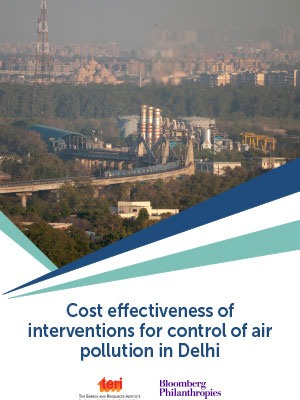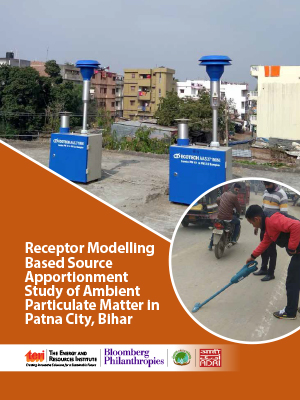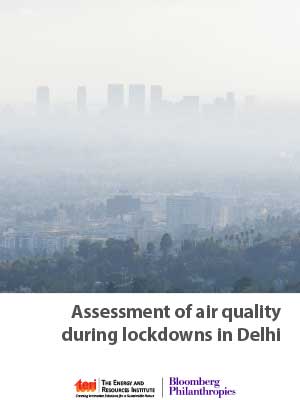Developing Strategies for Control of Air Pollution in India and its Cities
As part of India's efforts to curb air pollution, the project provides technical assistance to MoEF&CC on the National Clean Air Action Programme.
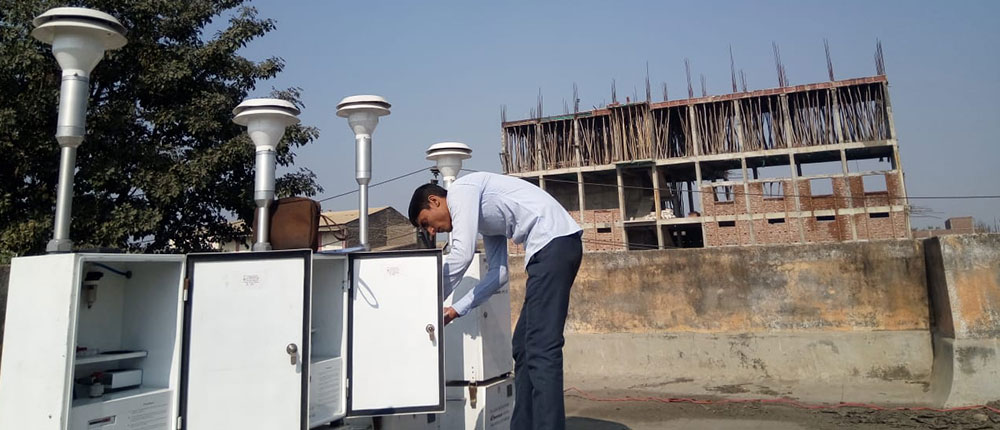
Air pollution is a major challenge faced globally, with detrimental environmental, health and economic impacts. India is at the forefront of the global struggle against air pollution as most of the cities where air quality is monitored show violation of prescribed ambient air quality standards. Various research studies have shown that not only major cities but the whole regions like Indo-Gangetic plains are under the influence of high air pollution. This has a significant impact on human health, agricultural productivity, and hence over the economy. Evidently, the interventions are required at both regional and city scales for control of pollution.
The main objective of the project is to help improve air quality in India. The project will include technical assistance to the Ministry of Environment, Forest and Climate Change (MoEF&CC) on its landmark National Clean Air Action Programme (NCAP) including through assistance for three Indian cities (and associated states and state pollution control boards) over a period of 2-3 years. This could cover the following activities: at national and city scales are:
National scale
- Development of a database of national-level multi-pollutant emission inventories
- Conduct a series of roundtables to discuss the sectoral air pollution mitigation measures at the national scale
City scale (at selected cities)
- Drafting a clean air action plan based on source apportionment study, intervention analysis to assess different control strategies in three cities (Patna, Surat, and Bangalore)
- Drafting an emergency action plan based on source apportionment of high episodic events in three cities (Patna, Surat, and Bangalore)
- Conducting cost-benefit analysis of air pollution control options for Delhi
- Conducting training programs for SPCB and other local authorities demonstrating the use of air quality modeling techniques for air quality management among Indian cities,
- Communicating air quality information at the city level to enhance public awareness.
Supported by Bloomberg Philanthropies, project objectives will be achieved through several activities, which are planned to executed by various agencies like TERI, Shakti Sustainable Energy Foundation and local partners ADRI, Urban emissions, Center for Study of Science, Technology and Policy (CSTEP) and WRI.
TERI has identified three key measures to significantly reduce air pollution at the national level:
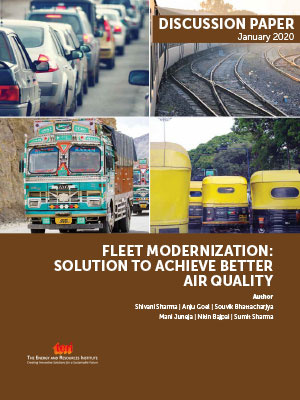
Fleet Modernization: Phase-wise implementation of fleet modernization (transforming pre BS-IV commercial vehicles to BS-VI) would lead to a 40-80% reduction in PM and NOx emissions from the sector by 2025.
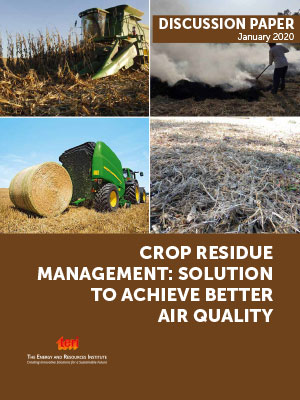
Crop Residue Management: Residents of different cities (probably villages too) of India breathe some of the least healthy air of the globe. During 2017, about 76.8% of the population of India was exposed to annual population-weighted mean PM2·5 greater than the limit recommended by the National Ambient Air Quality Standards.
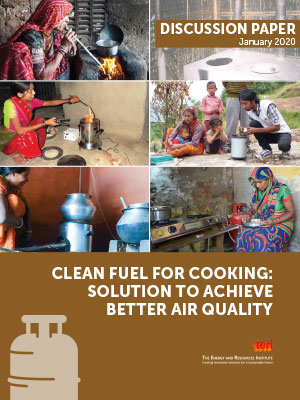
Clean Fuel for Cooking: The publication aims to analyse and estimate the financial support that may be required to encourage Pradhan Mantri Ujjwala Yojana (PMUY) consumers to switch to LPG
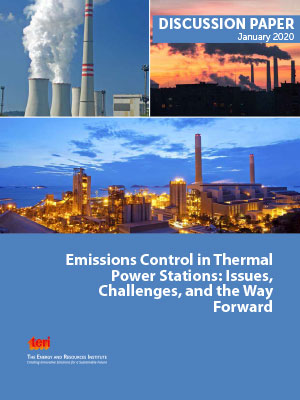
Emission control in thermal power stations: This publication aims to present an overview of new environmental norms for thermal power plants, their implementation status, factors coming in way of their implementation, as well as suggested measures, wherever possible.
Cost effectiveness of interventions for control of air pollution in Delhi
Launched on: 9 December 2021
The broad objective of this study is to assess cost-effectiveness of various options to reduce air pollution in Delhi. This will require assessment of PM2.5 source contributions in 2019, analysis of impact of different interventions on air quality, and estimation of cost effectiveness of different interventions.
The broad conclusions of this study are:
- Air pollution levels are appreciably higher than the prescribed standards in Delhi and adjoining areas. PM2.5 concentrations in Delhi during 2019 violate the annual average standards by about 3times.
- Transport (23%), industries including power plants (23%), and biomass burning (14%), are the major contributors to winter season PM2.5 concentrations in NCT Delhi during 2019.
- In the BAU scenario, the winter season PM2.5 concentrations are expected to fall by 9%, 21%, and 28% in 2022,2025, and 2030, w.r.t BAU 2019 respectively, despite which the levels will remain significantly above the standards.
- More stringent controls will be required to control emissions in the entire NCR and the rest of the airshed to bring winter season PM2.5 levels down considerably.
- NCR and airshed level controls can reduce winter season PM2.5 concentrations by 19-27%, and 35-47% by the year 2022-2030 w.r.t BAU.
- Effect of regional scale pollution is pronounced in Delhi’s PM2.5 concentrations and hence, regional level air quality planning and implementation is recommended for effective control of pollution in the entire region.
- Based on cost-effectiveness analysis, the following interventions are selected which shows negative costs or low cost to PM2.5 reduction ratios:
- Full LPG/induction stoves penetration
- Use of agriculture residue in power plants
- 2-w and 3w vehicles on Electric modes
- Enforcement of Zig-Zag brick kiln technology
- Power plant controls -implement stricter NOx and SO2 standards with continuous monitoring 6. Fuel switch from solid to gaseous fuels in industries
- Vacuum cleaning of all arterial roads
- Control of dust from construction activities- barriers and fogging based controls.
- Fleet modernization of Trucks and buses (in short term when the abundance of old vehicles is high)
- Some of the interventions are net negative cost options as they generate net economic benefits over a period of time. These include strategies like LPG penetration, induction cook-stoves, zig-zag brick kilns, use of agriculture residue in power plants, etc.
Receptor Modelling Based Source Apportionment Study of Ambient Particulate Matter in Patna City, Bihar
Authors: Dr Sumit Sharma, Mr Suresh Ramasubramanya Iyer, Dr Arindam Datta, Mr Mrinal Alexander Emmanuel, Ms Varsha Gupta, Mr Md Hafizur Rahman, Mr Justin Jacob, Dr Anju Goel and Mr Ved Prakash Sharma
Launched on: 27 August 2021
The study is a comprehensive evaluation of the concentration of particulate matter (PM) in Patna’s air, which is emitted from various sources in and around the city.
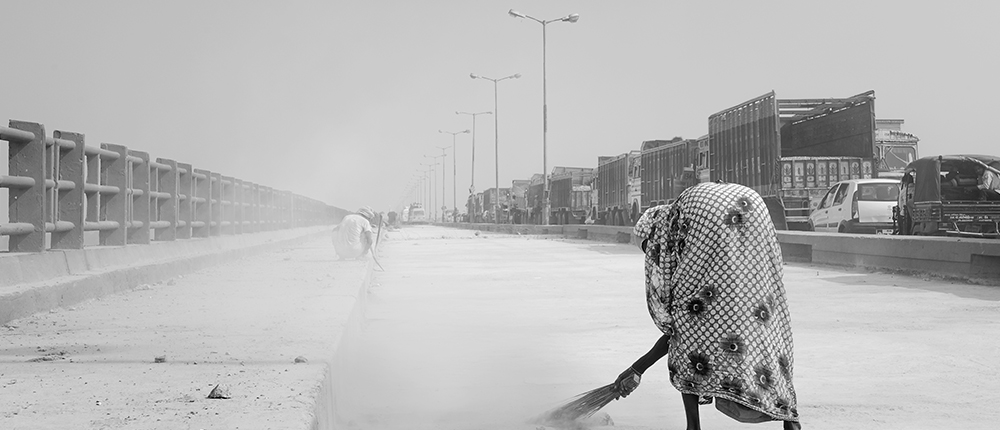
Patna has been listed as one of the most polluted cities among 122 non-attainment cities in India. To effectively control pollution in the city it is important to determine the contribution of different sectors and sources to the ambient air pollution.
In this regard, TERI carried out a source apportionment study (using receptor modelling method) of ambient particulate matter (PM) in 2021 in collaboration with the Centre for Environment Energy and Climate Change at the Asian Development Research Institute (CEECC, ADRI) with technical support from Bloomberg Philanthropies and Bihar State Pollution Control Board (BSPCB).
The study was launched on August 27, 2021 at Aranya Bhawan, Department of Environment headquarters, Patna, by Hon’ble Minister Shri Neeraj Kumar Singh, Department of Environment, Government of Bihar.
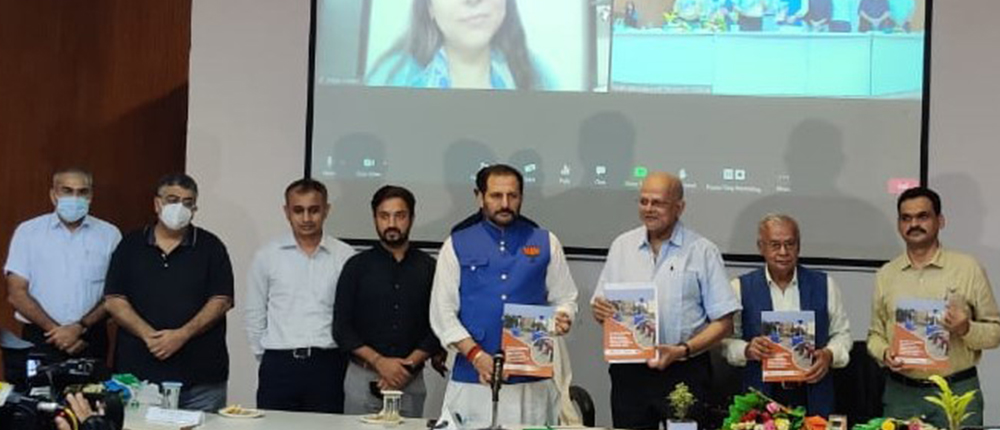
The study findings were presented by R Suresh, Fellow and Area Convenor, TERI. Others who addressed the event included Dr AK Ghosh, chairman of Bihar Pollution Control Board (BPCB); Suruchi Bhadwal, Director, TERI; P Ghosh of ADRI, S Chandrashekhar, Member Secretary, BPCB; and Pooja Tiwari of Bloomberg Philanthropies. The event was attended by officials both physically and through virtual platforms.
Systematic assessment of ambient air quality and quantification of sources of pollution is a pre-requisite for taking necessary measures for control. Hence, this study is a comprehensive evaluation of the concentration of particulate matter (PM) in the air, which is emitted from various sources in and around the city. Ground-based ambient air quality monitoring was conducted at several locations in Patna. It was based on the protocol and guidelines prescribed by the CPCB, which are used to assess the contribution of sources to pollution in the city.
Seven ambient air quality monitoring locations (receptor locations) were selected based on different land-use categories within the city. The 24-hourly ambient air quality monitoring was carried out at each of the selected locations continuously for 15 days for PM10 and PM2.5 samples using quartz and teflon filters.
Summer monitoring was carried out in May-June 2019 and winter monitoring in December 2019 - January 2020. Chemical characterisation of the collected PM10 and PM2.5 samples was carried out. These were then fed along with source profiles into the CMB receptor model to derive source contributions of PM10 and PM2.5 in the city of Patna.
Based on the results, specific strategies for control of pollution in the city of Patna have been suggested:
- Development of a regional scale plan for control of pollution in Bihar with Patna and other important cities as hotspots.
- A green belt with local dense canopy tree species on the bank of river Ganga to stop the windblown dust sediments reaching the city.
- Dust control at major construction sites in the city through barriers, cleaning, and dust suppressants.
- Regular mechanical sweeping of city roads (including minor roads), particularly near the construction sites.
- Legislation on use of cleaner fuels (gas/electricity) instead of biomass and coal in industries/brick kilns around Patna city, else real-time monitoring of stacks and mandatory use of high-efficiency control devices with standards to be made more stringent.
- Capacity building of SPCB with more budgetary allocations, staff, skill sets, and equipment.
- Penetration of LPG in district in a time-bound manner and distribution of two free cylinders, in winter, to people below poverty line.
- Improvement of vehicular inspection and maintenance programme (experiment with remote sensing technology) in and around Patna city.
- Enhancement of public transport system, preferably on electric modes, and installation of electric charging infrastructure.
- State-level fleet modernization plan with concessions on registration fees to old vehicle owners for early fleet modernization; heavy penalties on unregistered, visibility polluting vehicles.
- Awareness programme to encourage people for non-motorized transportation within 5 to 6 km in the city and introduction of non-motorized lanes wherever possible within the city.
- Increase plantation in open spaces within city, wherever possible.
- Development of graded response plan, emergency response plan, and forecasting system for early warnings.
Assessment of air quality during lockdowns in Delhi
Report Authors: Dr Sumit Sharma, Mr Suresh Ramasubramanya Iyer, Dr Arindam Datta, Mr Prabhat Sharma, Md. Hafizur Rahman
Launched on: 2 February 2021
Assessing the air pollution before and after Covid-19 lockdowns in Delhi, the report findings reveal PM2.5 violating daily limits despite reduction in pollution.
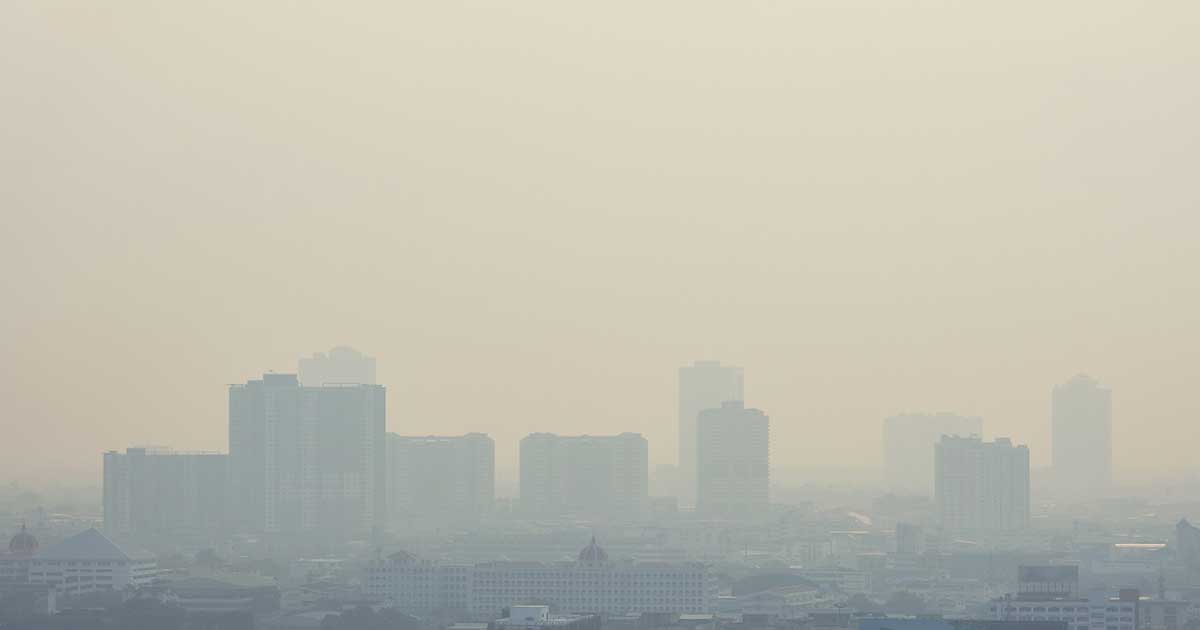
Air quality has become a primary concern in India. Covid-19 pandemic has touched all spheres of human lives and the lockdowns enforced for control of the Covid-19 spread have resulted in significant air quality improvement. The study aimed at examining the impacts of restricted source activity during the lockdown period (March to June, 2020) on the ambient air quality (particulate matter concentrations) of Delhi and carry out chemical speciation and source profiling of the sources contributing to the PM concentrations during this period of restricted activities of the local sources. This analysis has been carried out to understand the air quality variation observed in Delhi during the lockdowns. The major findings which can be drawn out of the overall study are:
- Reductions (43% and 61% in PM2.5 and NOx concentrations, respectively) observed in PM2.5 and NOx concentrations during lockdowns in 2020 with respect to 2019 were statistically significant.
- Despite lockdowns, PM2.5 levels violated the daily standard 31-60% of the 45 days monitoring period at the three of TERI's own monitoring locations, that is, Lodhi Road, Patel Nagar and Laxmi Nagar in Delhi.
- Contributions were found to be lower from transport, and higher from biomass and industrial combustion activities, indicating regional contributions from outside of Delhi.
- Air pollutant reductions during lockdowns shows that vehicles and industries are important sectors contributing to PM2.5 concentrations in Delhi, and controls over them (as in lockdowns) can lead to significant reductions in PM2.5 concentrations.
- Significantly high pollutant levels observed in Delhi despite restrictions point towards substantial contributions of several non-local sources and the need for delineation of airshed for Delhi and also for other non-attainment cities for development of effective air quality management plans.

The study concludes that an airshed based approach needs to be followed in order to address the air pollution problems in Delhi as despite severe restrictions on the local source emission activities, contributions from upwind locations kept the pollution levels in Delhi above the daily standard limit indicating contribution of non-local sources to the pollution levels. This study highlights importance of long-range transport of pollutants and provides a strong basis for following an airshed based approach for tackling the air pollution problems in the capital. Furthermore, it stresses on the need for delineation of airshed for each non-attainment city for development of airshed based air quality management plans.

